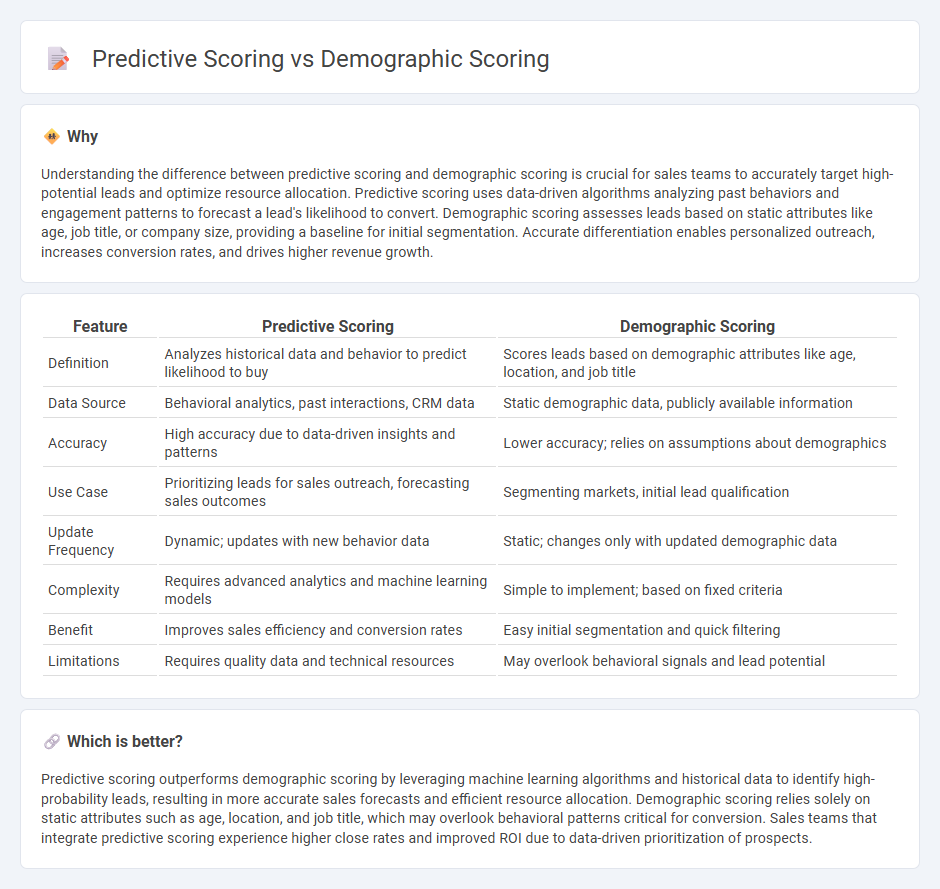
Predictive scoring uses historical data and machine learning algorithms to forecast the likelihood of a lead converting, optimizing sales efforts by targeting high-potential prospects. Demographic scoring assesses leads based on static attributes such as age, job title, and location, providing a straightforward but less dynamic evaluation. Explore how combining these approaches can enhance your sales strategy and improve conversion rates.
Why it is important
Understanding the difference between predictive scoring and demographic scoring is crucial for sales teams to accurately target high-potential leads and optimize resource allocation. Predictive scoring uses data-driven algorithms analyzing past behaviors and engagement patterns to forecast a lead's likelihood to convert. Demographic scoring assesses leads based on static attributes like age, job title, or company size, providing a baseline for initial segmentation. Accurate differentiation enables personalized outreach, increases conversion rates, and drives higher revenue growth.
Comparison Table
| Feature | Predictive Scoring | Demographic Scoring |
|---|---|---|
| Definition | Analyzes historical data and behavior to predict likelihood to buy | Scores leads based on demographic attributes like age, location, and job title |
| Data Source | Behavioral analytics, past interactions, CRM data | Static demographic data, publicly available information |
| Accuracy | High accuracy due to data-driven insights and patterns | Lower accuracy; relies on assumptions about demographics |
| Use Case | Prioritizing leads for sales outreach, forecasting sales outcomes | Segmenting markets, initial lead qualification |
| Update Frequency | Dynamic; updates with new behavior data | Static; changes only with updated demographic data |
| Complexity | Requires advanced analytics and machine learning models | Simple to implement; based on fixed criteria |
| Benefit | Improves sales efficiency and conversion rates | Easy initial segmentation and quick filtering |
| Limitations | Requires quality data and technical resources | May overlook behavioral signals and lead potential |
Which is better?
Predictive scoring outperforms demographic scoring by leveraging machine learning algorithms and historical data to identify high-probability leads, resulting in more accurate sales forecasts and efficient resource allocation. Demographic scoring relies solely on static attributes such as age, location, and job title, which may overlook behavioral patterns critical for conversion. Sales teams that integrate predictive scoring experience higher close rates and improved ROI due to data-driven prioritization of prospects.
Connection
Predictive scoring leverages historical sales data and customer behavior patterns to forecast future buying intentions, while demographic scoring categorizes prospects based on attributes such as age, income, and location. Combining these scoring methods enhances lead qualification by aligning predictive insights with demographic profiles, improving sales targeting accuracy. This integrated approach enables sales teams to prioritize high-potential leads and tailor strategies that align with specific customer segments.
Key Terms
Demographic Scoring:
Demographic scoring evaluates potential customers based on demographic data such as age, gender, income, education, and location to identify segments most likely to respond to marketing efforts. This method enables businesses to tailor campaigns by focusing on specific population characteristics, enhancing targeting accuracy and resource allocation. Discover more about how demographic scoring can drive strategic marketing decisions.
Firmographics
Demographic scoring evaluates prospects based on general characteristics such as age, gender, or location, whereas predictive scoring leverages firmographics--company-specific data like industry, company size, and revenue--to forecast the likelihood of successful business engagement. Firmographic data enhances predictive models by providing actionable insights into organizational behavior, market potential, and decision-making processes. Explore deeper insights into leveraging firmographics for data-driven sales and marketing strategies to optimize lead scoring and conversion rates.
Lead Qualification
Demographic scoring evaluates leads based on characteristics like age, location, industry, and job title, providing a straightforward way to segment potential customers for targeted marketing. Predictive scoring uses machine learning algorithms to analyze past behavior, engagement patterns, and historical conversion data, offering a dynamic and more accurate assessment of a lead's likelihood to convert. Explore detailed comparisons and insights to enhance your lead qualification strategy effectively.
Source and External Links
Ultimate Guide to Demographic Scoring Models - Demographic scoring ranks prospects based on attributes like company size, industry, and location to help sales teams prioritize the best leads.
What is a Demographic Score? - A demographic score assigns point values to specific demographic criteria (e.g., job title, revenue, industry) to numerically evaluate and prioritize prospects in a database.
Demographic vs. Behavioral Lead Scoring in B2B - Demographic lead scoring uses basic customer information (industry, company size, location) to target marketing, but risks oversimplifying customer diversity within groups.
 dowidth.com
dowidth.com